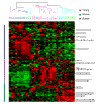Expression profiles during honeybee caste determination
- PMID: 11178278
- PMCID: PMC17597
- DOI: 10.1186/gb-2000-2-1-research0001
Expression profiles during honeybee caste determination
Abstract
Background: Depending on their larval environment, female honeybees develop into either queens or workers. As in other polyphenisms, this developmental switch depends not on genomic differences between queens and workers but on the differential expression of entire suites of genes involved with larval fate. As such, this and other polyphenic systems can provide a novel tool for understanding how genomes and environmental conditions interact to produce different developmental trajectories. Here we use gene-expression profiles during honeybee caste determination to present the first genomic view of polyphenic development.
Results: Larvae raised as queens or workers differed greatly in their gene-expression patterns. Workers remained more faithful than queens to the expression profiles of younger, bipotential, larvae. Queens appeared to both downregulate many of the genes expressed by bipotential larvae and turn on a distinct set of caste-related genes. Queens overexpressed several metabolic enzymes, workers showed increased expression of a member of the cytochrome P450 family, hexameric storage proteins and dihydrodiol dehydrogenase, and young larvae overexpressed two putative heat-shock proteins (70 and 90 kDa), and several proteins related to RNA processing and translation.
Conclusions: Large differences in gene expression between queens and workers indicate that social insect castes have faced strong directional selection pressures. Overexpression of metabolic enzymes by queen-destined larvae appears to reflect the enhanced growth rate of queens during late larval development. Many of the differently expressed genes we identified have been tied to metabolic rates and cellular responses to hormones, a result consistent with known physiological differences between queen and worker larvae.
Figures


References
-
- West-Eberhard M. Phenotypic plasticity and the origins of diversity. Annu Rev Ecol Syst. 1989;20:249–278.
-
- Gadagkar R. The evolution of caste polymorphism in social insects: genetic release followed by diversifying evolution. J Genet. 1997;76:167–179.
-
- Hartfelder K, Engels W. Social insect polymorphism: hormonal regulation of plasticity in development and reproduction in the honeybee. Curr Top Dev Biol. 1998;40:45–77. - PubMed
-
- Severson D, Williamson J, Aiken J. Caste-specific transcription in the female honeybee. Insect Biochem. 1989;19:215–220.
MeSH terms
Substances
LinkOut - more resources
Full Text Sources
Research Materials

